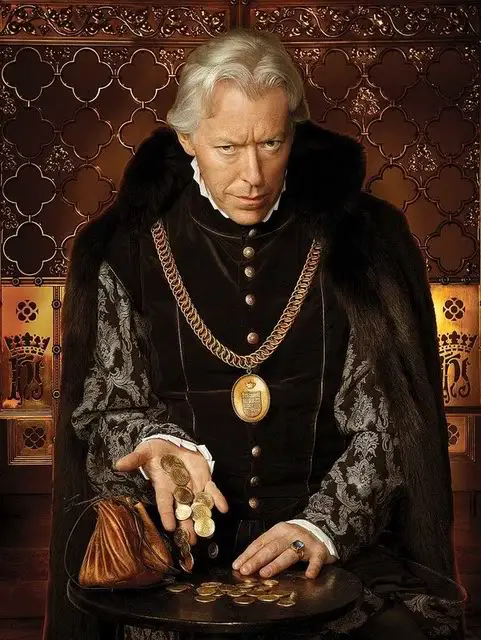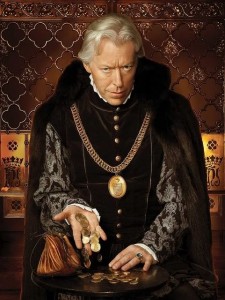Papa Boleyn: Satan in Disguise by Maddy Mikinski

 History is full of cruel fathers; Mozart had an overbearing, pushy, drunkard dad; Mihnea cel Rău had Vlad the Impaler (also known as Dracula); and Anne Boleyn had Thomas Boleyn. This cruel father has been portrayed in numerous ways. In BBC Filmsʼ The Other Boleyn Girl, he is seen as a victim of his brother-in-lawʼs ambitious scheming. This Thomas Boleyn follows the man who will ultimately lead to his childrenʼs demise like a lost puppy, brimming with optimism.
History is full of cruel fathers; Mozart had an overbearing, pushy, drunkard dad; Mihnea cel Rău had Vlad the Impaler (also known as Dracula); and Anne Boleyn had Thomas Boleyn. This cruel father has been portrayed in numerous ways. In BBC Filmsʼ The Other Boleyn Girl, he is seen as a victim of his brother-in-lawʼs ambitious scheming. This Thomas Boleyn follows the man who will ultimately lead to his childrenʼs demise like a lost puppy, brimming with optimism.
The Thomas portrayed in Showtimeʼs The Tudors is on a whole other side of the spectrum. This Boleyn is shifty, calculating, and in it only for himself. He exploits his daughters for himself under the guise that itʼs for the Boleyn family name.
Thomas, it appears, shared some traits with his daughter Anne. Anne Boleyn is most famous for her ascent from lowly lady-in-waiting to Queen of England (not to mention her responsibility for the creation of the Church of England). She is pinned as clever, sly, and ambitious. All these characteristics no doubt made it easier for Thomas to propel her onto the throne next to King Henry VIII.
For all his calculating and scheming, however, Thomasʼs first attempt failed. Before Anne, Thomas placed his daughter Mary in front of the king. (Mary Boleyn has been the subject of books such as Phillipa Gregoryʼs The Other Boleyn Girl and The Last Boleyn by Karen Harper.) Maryʼs affair with the king fizzled out after approximately four years due to her sister.Itʼs unclear whether Anne or Thomas made the first move towards the kingʼs attentions but Papa Boleyn definitely didnʼt stand in his daughterʼs way. In Boleynʼs experience, King Henryʼs favor led to wealth, infamy, and a plethora of new titles. An enterprising man like Boleyn could smell the opportunity for advancement from a mile away.
When Anne finally caught Henryʼs eye, it seemed Thomas hit the jackpot. In quick succession, Boleyn was awarded the titles Viscount of Rochford, Earl of Wiltshire and Ormond, and Lord Privy Seal. The Rochford title was later passed down to his only son George. Of course, Thomas kept the majority of titles for himself.The good news just kept on coming when George was set up with an advantageous marriage–a marriage that would elevate the familyʼs prestige. His sonʼs abhorrence of new wifey Jane Parker was no matter, as long as it furthered the family firm.
Finally, in 1533, Thomas got what he wanted. Anne–after seven years of courting–married King Henry. She was already pregnant at the time. For a minute, his ambitions were secure. Thomasʼs only problem was that there was no way of knowing the gender of Anneʼs child. He could only pray that it was a boy.
Henry had been married before. In fact, his gnarly divorce was what delayed nuptials with Anne. Wife #1 (Catherine of Aragon) had failed to provide a living male heir. Sure, some of their stillborn children were males but they could hardly rule England in the event of Henryʼs death. The only product of Henryʼs marriage to Catherine was a daughter named Mary (later to be Mary I). Mary was deemed unfit to rule because of the fact she was female. Observant man he was, Thomas knew the only way to solidify the kingʼs favor was to be the grandfather of the new Prince of Wales. But it seems fate hated him as much as his fellow courtiers did. In September of 1533, the Princess Elizabeth was born. Thomas was probably about as happy as Henry. His position hung in the balance along with his daughterʼs.
Anneʼs imminent miscarriages (one of which was a son) caused Thomasʼs master plan to crash and burn. Henry was becoming more testy with every pregnancy and blamed Anne for each “failure” (including the birth of a girl).Anneʼs arrest in 1536 marked the Boleynsʼ official fall from grace. Like the horrible father heʼs perceived to be, Thomas tried to extract himself from the situation with minimal damage to himself. In the meantime, George Boleyn was imprisoned in
relation to his sisterʼs arrest. For the next few weeks, Thomas watched his son and daughter be tried for their lives. Anne was found guilty of treason, adultery, and–along with her brother–incest. The judge of the court which sentenced his children to death was the Duke of Norfolk, Thomasʼs brother-in-law and Anneʼs uncle. The duke was also an instrument in Anneʼs rise to favor.
George Boleyn was executed on May 17 along with three of Anneʼs other “lovers”. Anne followed her brother to the scaffold on May 19.
After being disgraced by Henryʼs court, Thomas returned to his home in Kent. He died less than four years later.
The fascinating aspect of Thomas is his controversial image. From the distance of five hundred years, he seems just like the portrait The Tudors painted: heartless, cold, and pitiless. The thing is, until we invent a time machine and go back and see for ourselves, weʼll never truly know who Thomas Boleyn was. Was he a man willing to sacrifice anything–even his children–for wealth and titles? Or was he just a man caught between pleasing a capricious monarch and protecting his brood?
Could Thomas really have known the consequences of pushing Anne towards queendom?
Itʼs true that Anne was the first queen to be publicly executed but surely heʼd seen the kingʼs wrath before. King Henryʼs short temper was infamous. This was the same temper that had sealed the fate of Royal best friend and mentor Sir Thomas More.
Thomas Boleyn was a complicated man with equally complicated feelings which enthralls us more. Thomas has a mystique around him which no amount of research can remove. The question of his morality is in the hands of the people who hear about him and draw their own conclusions.